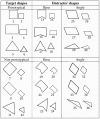The haptic recognition of geometrical shapes in congenitally blind and blindfolded adolescents: is there a haptic prototype effect?
- PMID: 22761961
- PMCID: PMC3386238
- DOI: 10.1371/journal.pone.0040251
The haptic recognition of geometrical shapes in congenitally blind and blindfolded adolescents: is there a haptic prototype effect?
Abstract
Background: It has been shown that visual geometrical shape categories (rectangle and triangle) are graded structures organized around a prototype as demonstrated by perception and production tasks in adults as well as in children. The visual prototypical shapes are better recognized than other exemplars of the categories. Their existence could emerge from early exposure to these prototypical shapes that are present in our visual environment. The present study examined the role of visual experience in the existence of prototypical shapes by comparing the haptic recognition of geometrical shapes in congenitally blind and blindfolded adolescents.
Methodology/principal findings: To determine whether the existence of a prototype effect (higher recognition of prototypical shapes than non prototypical shapes) depended on visual experience, congenitally blind and blindfolded sighted adolescents were asked to recognize in the haptic modality three categories of correct shapes (square, rectangle, triangle) varying in orientation (prototypical/canonical orientation vs. non prototypical/canonical orientation rotated by 45°) among a set of other shapes. A haptic prototype effect was found in the blindfolded sighted whereas no difference between prototypical and non prototypical correct shapes was observed in the congenitally blind. A control experiment using a similar visual recognition task confirmed the existence of a visual prototype effect in a group of sighted adolescents.
Conclusion/significance: These findings show that the prototype effect is not intrinsic to the haptic modality but depends on visual experience. This suggests that the occurrence of visual and haptic prototypical shapes in the recognition of geometrical shape seems to depend on visual exposure to these prototypical shapes existing in our environment.
Conflict of interest statement
Figures


References
-
- Piaget J, Inhelder B. La représentation de l'espace chez l'enfant. Paris: PUF. 1947.
-
- Feldman J. Bias toward regular form in mental shape spaces. Journal of Experimental Psychology: Human Perception & Performance. 2000;26:152–165. - PubMed
-
- Medin D, Schaffer M. Context model of classification learning. Psychological Review. 1978;85:207–238.
-
- Nosofsky R. Exemplar-based accounts of relations between classifications, recognition, and typically. Journal of Experimental Psychology: Learning, Memory & Cognition. 1988;14:700–708.
-
- Rosch E. Cognitive reference points. Cognitive Psychology. 1975;7:532–547.
MeSH terms
LinkOut - more resources
Full Text Sources

